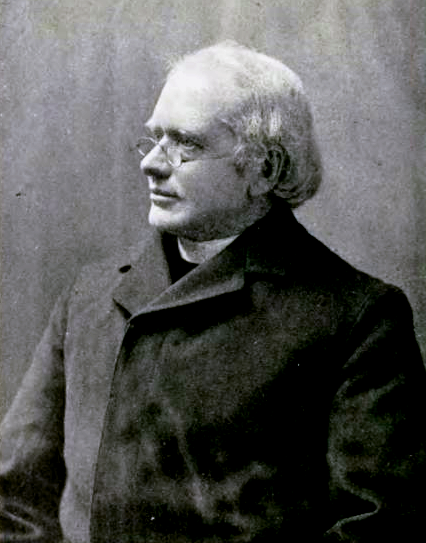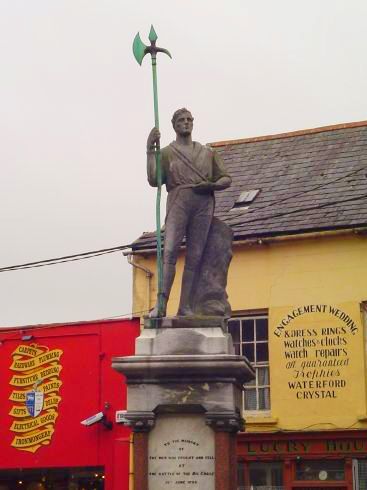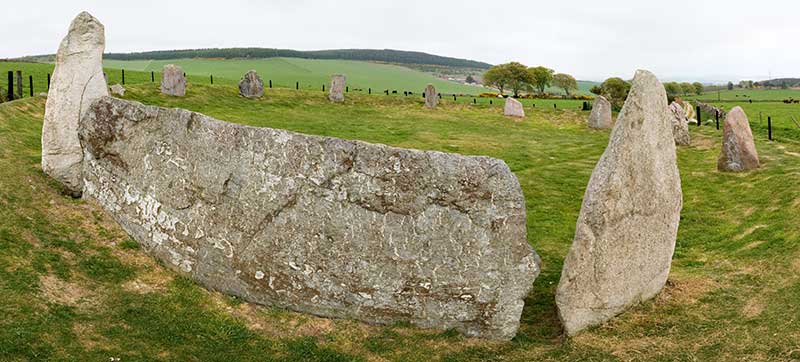|
Rosscarbery
Rosscarbery () is a village and census town in County Cork, Ireland. The village is on a shallow estuary, which opens onto Rosscarbery Bay. Rosscarbery is in the Cork South-West (Dáil Éireann) constituency, which has three seats. History The area has been inhabited since at least the Neolithic period, as evidenced by several Neolithic sites such as portal dolmens. The area is also home to a number of Bronze Age remains, including a number of stone circles and ring forts. There are two inscribed stones in Burgatia, and several (later) holy wells nearby. Rosscarbery was home to the School of Ross, a major centre of learning, at one time being a university town, and one of the major cities in Europe, around the 6th century. Due to its popularity as a centre of pilgrimage it was also known as ''Ros Ailithir ("Wood of the Pilgrims")''. The hereditary chieftains of the area, or tuath, were the O'Learys, known as Uí Laoghaire Ruis Ó gCairbre, until it passed to Norman control i ... [...More Info...] [...Related Items...] OR: [Wikipedia] [Google] [Baidu] |
Tom Barry (Irish Republican)
Thomas Bernardine Barry (1 July 1897 – 2 July 1980), better known as Tom Barry, was a prominent guerrilla warfare, guerrilla leader in the Irish Republican Army (1919–1922), Irish Republican Army (IRA) during the Irish War of Independence and the Irish Civil War. He is best remembered for orchestrating the Kilmichael Ambush, Kilmichael ambush, in which he and his column wiped out a 18-man patrol of Auxiliary Division, Auxiliaries, killing sixteen men. Born in County Kerry, Barry was the son of a former Royal Irish Constabulary constable. In 1915, at the age of seventeen, he joined the British Army and would go on to see action as a gunner in the Middle Eastern theatre of World War I, Middle East during the World War I, First World War. Despite expressing some British patriotism during his early years, Barry's views slowly began to change towards Irish republicanism. In his memoir, Barry stated that this started shortly after he heard about the Easter Rising in 1916, though r ... [...More Info...] [...Related Items...] OR: [Wikipedia] [Google] [Baidu] |
Cork South-West (Dáil Constituency)
Cork South-West is a parliamentary constituency represented in Dáil Éireann, the lower house of the Irish parliament or Oireachtas. The constituency elects three deputies ( Teachtaí Dála, commonly known as TDs) on the system of proportional representation by means of the single transferable vote (PR-STV). History and boundaries It is a largely rural constituency within County Cork, running from Dursey Island in the west to Ringabella in the east, with many medium-sized towns, including Bandon, Bantry, Castletownbere, Clonakilty, Kinsale and Skibbereen. It was first used at the 1961 general election. The Electoral (Amendment) (Dáil Constituencies) Act 2017 defines the constituency as: The Constituency Review Report 2023 of the Electoral Commission recommended that no change be made at the 2024 general election. TDs Elections 2024 general election 2020 general election 2016 general ele ... [...More Info...] [...Related Items...] OR: [Wikipedia] [Google] [Baidu] |
School Of Ross
The School of Ross was a monastic institution located in what is now called Rosscarbery, County Cork, Ireland, but formerly ''Ross-Ailithir'' (Ross of the Pilgrims), from the large number of monks and students who "flocked" to it from all over Europe. Founding The school was founded by St. Fachtna, who is generally regarded as the same person who founded the Diocese of Kilfenora; the feast in both cases is kept on 14 August, and in both the saint's descent is traced to the princely race of Corcu Loígde. Fachtna was born at a place called Tulachteann, and died at the early age of forty-six, probably late in the sixth century, and is buried in his own cathedral church in Rosscarbery, a tuath of which the O'Leary were hereditary lords. The ''Annals of Innisfallen'' (Dublin copy) mark 600 as the year of his death: "Died Fachtna first Bishop of Ross-Ailithre in Corca-Laidhe which goes by the additional name of O'Laeghaire of Ross i.e. Corca Laidhe-I-Laeghaire Ruis". Like many ot ... [...More Info...] [...Related Items...] OR: [Wikipedia] [Google] [Baidu] |
3rd Cork Brigade
The 3rd Cork Brigade, also known as Third (West) Cork Brigade, was a unit of the Irish Republican Army that operated in the western areas of County Cork during the Irish War of Independence. The unit was commanded by Tom Barry for most of the conflict and was responsible for the Kilmichael Ambush and Crossbarry Ambush. Charlie Hurley took command of the brigade during Tom Barry's illness in 1920. Activities Under the command of Tom Barry, who later described many of the unit's activities in '' Guerrilla Days in Ireland'' (1949), the 3rd Cork Brigade was one of the most active during the Irish War of Independence. Its actions were focused on the West Cork area, and included the Kilmichael Ambush in November 1920, which resulted in the deaths of 18 members of the Auxiliary Division, and the Crossbarry Ambush of March 1921, during which the unit escaped encirclement by 1,200 British troops. Other activities, planned by the unit, were aborted. For example, a planned attack on a ... [...More Info...] [...Related Items...] OR: [Wikipedia] [Google] [Baidu] |
Bishop Of Cork, Cloyne And Ross
The Bishop of Cork, Cloyne and Ross is the Church of Ireland Ordinary of the united Diocese of Cork, Cloyne and Ross in the Province of Dublin. The current bishop is the Right Reverend Paul Colton BCL, DipTh, MPhil, LLM, PhD. He was consecrated bishop at Christ Church Cathedral, Dublin, on Thursday 25 March 1999; the Feast of the Annunciation The Feast of the Annunciation () commemorates the visit of the archangel Gabriel to the Virgin Mary, during which he informed her that she would be the mother of Jesus Christ, the Son of God. It is celebrated on 25 March; however, if 25 Marc .... He was enthroned in St. Fin Barre's Cathedral, Cork on 24 April 1999, in St Colman's Cathedral, Cloyne on 13 May 1999, and in St. Fachtna's Cathedral, Ross on 28 May 1999.Biography: Paul Colton . Retrieved on 27 December 2008. [...More Info...] [...Related Items...] OR: [Wikipedia] [Google] [Baidu] |
O'Leary
O'Leary is an Irish surname derived from the Gaelic Ó Laoghaire, meaning "descendant of Laoghaire"—a personal name often interpreted as "keeper of the calves" or "calf herder." The name is historically associated with a prominent family lineage in County Cork, Ireland, where the O'Learys were chieftains in the ancient kingdom of Munster. Over time, individuals bearing the O'Leary surname have become notable in various fields such as politics, military service, literature, and religion, both in Ireland and abroad. History Ancient The Uí Laoghaire clan, today associated with the Uibh Laoghaire parish in County Cork, is considered by scholars to have originated in the early Middle Ages on the south-west coast, in the area of Ros Ó gCairbre ( Rosscarbery), of which the O'Leary were hereditary lords. The Annals of Innisfallen (Dublin copy) records St. Fachtna's ( Saint Fachanan) death in 600 AD as occurring in "O'Laeghaire of Ross i.e. Corca Laidhe-I-Laeghaire Ruis". The clan trac ... [...More Info...] [...Related Items...] OR: [Wikipedia] [Google] [Baidu] |
Clonakilty
Clonakilty (; ), sometimes shortened to Clon, is a town in County Cork, Ireland. The town is at the head of the tidal Clonakilty Bay. The rural hinterland is used mainly for dairy farming. The town's population was 5,112 at the 2022 census. The town is a tourism hub in West Cork, and was recognised as the "Best Town in Europe" in 2017, and "Best Place of the Year" in 2017 by the Royal Institute of the Architects of Ireland. Clonakilty is in the Dáil constituency of Cork South-West, which has three seats. Clonakilty became Ireland's first Autism-friendly town in 2018. History The Clonakilty area has a number of ancient and pre-Celtic sites, including Lios na gCon ringfort. Norman settlers built castles around Clonakilty, and a number of Norman surnames survive in the West Cork area to the present day. In 1292, Thomas De Roach received a charter to hold a market every Monday at Kilgarriffe (then called Kyle Cofthy or Cowhig's Wood), close to where the present town now s ... [...More Info...] [...Related Items...] OR: [Wikipedia] [Google] [Baidu] |
Stone Circle
A stone circle is a ring of megalithic standing stones. Most are found in Northwestern Europe – especially Stone circles in the British Isles and Brittany – and typically date from the Late Neolithic and Early Bronze Age, with most being built between 3300 and 2500 BC. The best known examples include those at the henge monument at Avebury, the Rollright Stones, Castlerigg, and elements within the ring of standing stones at Stonehenge. Scattered examples exist from other parts of Europe. Later, during the Iron Age, stone circles were built in southern Scandinavia. The archetypical stone circle is an uncluttered enclosure, large enough to congregate inside, and composed of megalithic stones. Often similar structures are named 'stone circle', but these names are either historic, or incorrect. Examples of commonly misinterpreted stone circles are ring cairns, burial mounds, and kerb cairns. Although it is often assumed there are thousands of stone circles across the Br ... [...More Info...] [...Related Items...] OR: [Wikipedia] [Google] [Baidu] |
Holy Well
A holy well or sacred spring is a well, Spring (hydrosphere), spring or small pool of water revered either in a Christianity, Christian or Paganism, pagan context, sometimes both. The water of holy wells is often thought to have healing qualities, through the numen, numinous presence of its guardian spirit or Christian saint. They often have local legends associated with them; for example in Christian mythology, Christian legends, the water is often said to have been made to flow by the action of a saint. Holy wells are often also places of ritual and pilgrimage, where people Prayer, pray and leave votive offerings. In Celtic nations, Celtic regions, strips of cloth are often tied to trees at holy wells, known as clootie wells. Names The term ''haeligewielle'' is in origin an Old English language, Anglo-Saxon toponym attached to specific springs in the landscape; its current use has arisen through folklore scholars, antiquarians, and other writers generalising from those actual ' ... [...More Info...] [...Related Items...] OR: [Wikipedia] [Google] [Baidu] |
Europe
Europe is a continent located entirely in the Northern Hemisphere and mostly in the Eastern Hemisphere. It is bordered by the Arctic Ocean to the north, the Atlantic Ocean to the west, the Mediterranean Sea to the south, and Asia to the east. Europe shares the landmass of Eurasia with Asia, and of Afro-Eurasia with both Africa and Asia. Europe is commonly considered to be Boundaries between the continents#Asia and Europe, separated from Asia by the Drainage divide, watershed of the Ural Mountains, the Ural (river), Ural River, the Caspian Sea, the Greater Caucasus, the Black Sea, and the waterway of the Bosporus, Bosporus Strait. "Europe" (pp. 68–69); "Asia" (pp. 90–91): "A commonly accepted division between Asia and Europe ... is formed by the Ural Mountains, Ural River, Caspian Sea, Caucasus Mountains, and the Black Sea with its outlets, the Bosporus and Dardanelles." Europe covers approx. , or 2% of Earth#Surface, Earth's surface (6.8% of Earth's land area), making it ... [...More Info...] [...Related Items...] OR: [Wikipedia] [Google] [Baidu] |
Sept
A sept () is a division of a family, especially of a Scottish or Irish family. The term is used both in Scotland and in Ireland, where it may be translated as Irish , meaning "progeny" or "seed", and may indicate the descendants of a person (for example, , "the descendant of Brian MacDermott"). The word may derive from the Latin , meaning "enclosure" or "fold", or via an alteration of the English-language word "sect". Family branches ''Síol'' is a Gaelic word meaning "progeny" or "seed" that is used in the context of a family or clan with members who bear the same surname and inhabited the same territory,"Septs of Ireland" Irish Septs Association. as a manner of distinguishing one group from another; a family called ''Mac an Bháird'' ( |




